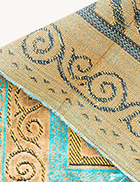 Με ακριβά κρασιά το κελάρι των ανώτατων δικαστών μέσα στο Ευρωπαϊκό Δικαστήριο
Με ακριβά κρασιά το κελάρι των ανώτατων δικαστών μέσα στο Ευρωπαϊκό Δικαστήριο
by Justin Stares
The European Court of Justice has built up a wine collection of almost 4,000 bottles worth at least €70,000 but denies claims judges are spending public money on their favourite vintages
Given the savage budget cuts across member states, it is not surprising that the European Court of Justice is reticent to reveal details of its Luxembourg wine cellar. According to the rumour mill, the 27 senior judges quaff quality vintages in a dining room to which mortals have no access. Some say they intervene personally to decide which wines should be purchased with public money every year.
Is this true? The initial responses from the court are non-committal. The institution has a “functioning wine cellar”, not a collection of fine and rare wines, the press and information unit underlines. “Like all the EU institutions, the court carries out a number of protocol activities, including welcoming various dignitaries, some of whom are provided with food and drink as appropriate,” the press department tells PublicServiceEurope.com.
It adds: “This wine is purchased in accordance with the EU’s financial regulations and the principal reason for the court having a wine cellar built up over the years is to allow the court to save money, as you can imagine buying the wine as and when needed from a supplier would cost considerably more.” There is evidently no court sommelier, merely staff well versed in wine.
After two months of gentle and then less gentle prompting, the court agrees to release further details. There are 3,729 bottles currently in the cellar, of which 2,920 are red and 809 are white. The average red was purchased at a price of €21.82, while the average white was worth almost €12. The entire collection, therefore, has a price tag of around €70,000, though some of the bottles are sure to have increased in value over time. Purchases are made via tender once a year. On one recent occasion, only white wine was required as the cellar was considered too heavy in reds. The court spends, on average, around €15,000 a year on wine.
Can we see the wine list? Unfortunately not. Making the list public, according to the court, is not possible as it would in some way compromise the tender process. Is this a satisfactory answer? We leave it to our readers to decide. As a compromise, court officials did agree to release details of what they say are the oldest bottles in the cellar. These include: two bottles of Rioja Marques del Romerol 1988; three bottles of Rioja Prado Enea 1991; 23 bottles of Pomerol Bordeaux Chateau Bellegrave 1998; 14 bottles of Nuits Saint George Bourgogne Les Vaucrains 1999 and eight bottles of an undefined “Barolo 1998”. Among the whites, the Bourgogne Puliguy Montrachet 2000 is said to be the oldest, of which there are also eight bottles.
The collection at first sight “does not look super impressive”, says Sylvain Bournigault, a wine trader consulted by PublicServiceEurope.com. The Marques del Romeral “seems to be more of a supermarket wine than a boutique selection”. The Prado Enea, on the other hand, is produced by Muga “which is one of the best in Rioja”. The Barolo 1998 “could be anything” given that no details were given. All of these wines, including the Pomerol, are probably past their peak and should have been drunk a while ago, Bournigault points out. Maybe the court does need a sommelier after all.
There is insufficient detail about the Vaucrains or the Puligny to make an assessment, given the numerous producers, says Bournigault. “I really would need a more detailed list to tick what seems outstanding,” he says, though given that it took two months of pestering to coax this much out of the court, more information is a tall order. The relatively high average bottle price means that there is likely to be “a few pearls” in the cellar, Bournigault says.
And what of rumours that the court’s judges pick their own wines? Gil Carlos Rodriguez Iglesias, a Spanish judge and former court president, wrote that this had taken place at least once. In a speech he gave in 1999, Iglesias praised a former British judge, the late Lord Slynn of Hadley, for the “contribution” the aristocrat had made to the cellar. “I can also vouch for the fact that Lord Slynn is quite an oenological expert,” Iglesias said as part of a presentation on Europe’s alcoholic beverages case-law. Iglesias continued: “It will therefore not be a surprise to learn that during his time in Luxembourg he made quite a contribution, not only to the court’s case-law but also to its wine cellar.”
Juan-Carlos Gonzalez, head of the the court’s press team, says: “No way is this true”. The judges did not and do not participate in the filling of the wine cellar, according to Gonzalez. Indeed, the image of highly paid judges meeting in a private lounge to discuss how to funnel public money into their favourite vintages would be a little hard to swallow in the current climate.
publicserviceeurope.com









